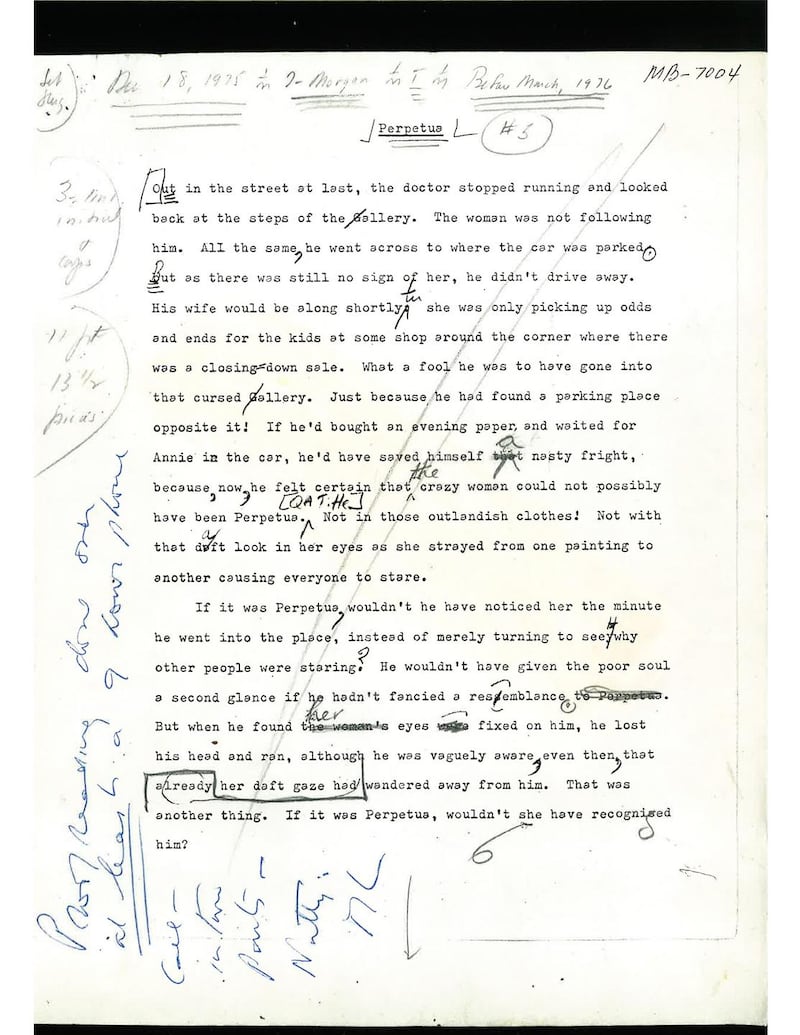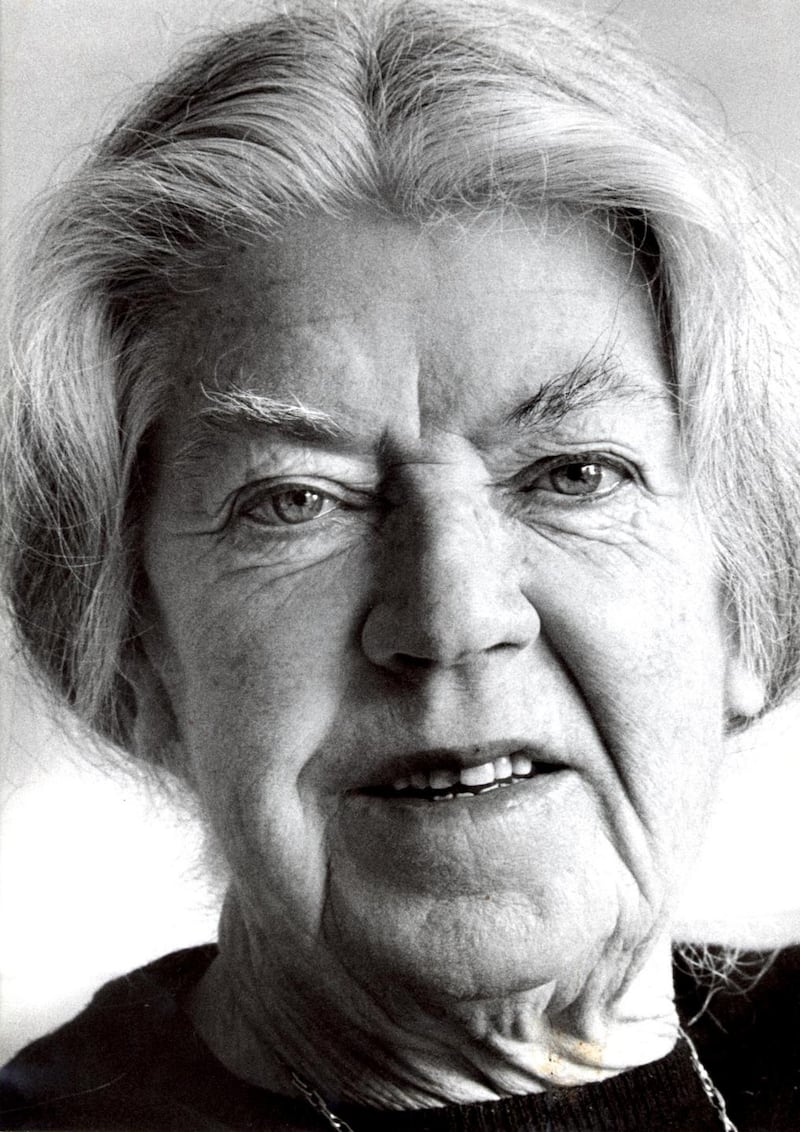The new Mary Lavin Square in Dublin links Lad Lane, where the author lived and hosted her impromptu literary salon, to Wilton Park. Lavin purchased her Lad Lane mews in 1958, using the proceeds from her first New Yorker story as the deposit (the magazine paid $935 for the story, the equivalent of €8,500 in today’s currency, from which her literary agency, Russell & Volkening, received a 10 per cent fee).
Lavin’s fortunes had changed considerably since the magazine first made overtures to her a year previously. At that time she was a financially strapped widow raising three young daughters, caring for her ailing widowed mother and managing a farm. She had only recently returned to writing following the death of her husband in 1954 and was evidently in the midst of a creative impasse.
JD Salinger, with whom she had been corresponding about American publishing opportunities, had recommended her to the New Yorker as a potential contributor. The magazine duly made contact and invited her to submit her fiction for consideration, although it could not guarantee acceptance of her work. Nevertheless, this communication gave Lavin a much welcomed creative boost and sparked a flurry of work, prompting her to write over 30,000 words in 10 days. The New Yorker would ultimately publish 16 of her stories over an 18-year period, a figure that surpassed Salinger’s contribution.

Lavin’s stories were published in other prominent American magazines prior to their inclusion in the New Yorker but she was never sure as to whether Diarmuid Russell, her literary agent of over 20 years, submitted her work to the publication for consideration. It was partly due to this uncertainty that early on in Lavin’s dealings with the New Yorker she ceased using Russell’s services and instead chose to deal directly with the magazine.
It was a savvy move on Lavin’s part as aside from the financial benefit, which was not a driving factor in her decision, it gave her greater control in managing her work. Rather than receive information third-hand or suffer doubt as to whether stories were sent to the New Yorker, Lavin could push for and negotiate the sale of her fiction herself. It also led to more direct contact with her editors than she would perhaps normally have had, particularly with her chief New Yorker editor, Rachel MacKenzie.
The New Yorker operated a strict policy of only printing unpublished work and so in order to encourage writers to submit original pieces, it offered a first-reading agreement to some of its regular contributors, one of whom was Lavin. This contract gave the magazine first refusal of her work in return for an annual retainer plus a 25 per cent bonus over the basic price of each story it bought.
Seen as an incentive for writers, it also gave the New Yorker the opportunity to procure the best work while circumventing any haggling with other interested parties. The magazine saw the remuneration as binding the deal or the bargain, but John Updike’s biographer, Adam Begley, viewed its aim as more to “to bind the young writer [Updike] to the magazine.”
It was a double-edged sword; while the contract gave Lavin a certain security with the New Yorker, it also meant that she put all her efforts into writing for it with no assurance of acceptance. Although Lavin preferred for her stories to be placed in the New Yorker, for both prestigious and financial purposes, ultimately she knew that she could get rejected work published elsewhere. Such a pragmatic outlook was crucial for a commercial writer whose writing was her main source of income.
Lavin’s success with the New Yorker was due in no small part to her extremely productive working relationship with MacKenzie, who was also a writer and contributor to the magazine. MacKenzie recognised Lavin’s talent and cultivated her as a New Yorker writer. Their combined revision of the stories was mainly conducted through lengthy correspondence but also via the occasional phone call and in person when Lavin visited New York. Their letters gradually became more personal, prompted perhaps by MacKenzie’s more intimate approach.
A fellow New Yorker editor, Charles “Chip” McGrath, observed that MacKenzie “was a bluestocking, a former college professor, who had a discerning eye for talent (she more or less discovered Isaac Singer and was a supporter of the young Philip Roth) and a way of becoming overly attached to her writers.”

Some New Yorker writers, notably Shirley Hazzard and Muriel Spark, found her approach somewhat smothering, so much so that, according to Spark’s biographer, Martin Stannard, she demanded another editor in the magazine. Lavin, however, did not appear to have any issues with MacKenzie’s maternal and familiar ways, perhaps because she shared a similar nurturing approach to writing, revision and budding writers.
MacKenzie, in her role as editor, viewed texts as malleable; her objective was to tailor Lavin’s stories to suit the magazine’s requirements. Lavin viewed her writing as an ongoing work-in-progress and, as a result, she was generally amenable to having her work revised. She also knew that she could she could return to her stories and restore her original conception of them.
Lavin’s habit was to write numerous stories simultaneously with multiple drafts of each. She explained her writing practice to MacKenzie when sending her a draft of The Bridal Sheets: “It’s only a very rough version but if you don’t mind reading it like this, it helps me, as I can get on with a new story, & I always like to let a story settle as I write (like a frame!) before I go at it again.”
The New Yorker promoted brevity in its fiction and, as a result, Lavin’s typically lengthy submissions were usually cut and condensed. Even though Lavin recognised that some stories were too long for the magazine, she still preferred to await MacKenzie’s feedback and direction before she pruned them.
Stories also had to conform to the New Yorker’s notorious idiosyncratic house rules, for example, the magazine preferred not to publish fiction featuring writers. Another rule was that stories had to conform to the season in which they were published. As a result, some of Lavin’s stories had to be modified in order to comply with such house rules, but allowing these changes resulted in their publication.
Lavin greatly appreciated and readily acknowledged the work MacKenzie did on her stories, as revealed when she wrote to her: “As usual I am grateful for the sharpening of both the story and the author! I always think – why couldn’t I see that myself!”
While some changes were agreeable to Lavin and she retained them in future publications, nevertheless, she did not view the New Yorker versions as definitive and she continued to revise and polish the stories. Not all magazines and journals shared the New Yorker’s strict policy of publishing only original writing and so its contributors had the option to capitalise on recycling a story several times after its initial appearance in the magazine. In Lavin’s case, all of her New Yorker stories were republished in magazines, journals and anthologies and several of her collections bore the titles of her New Yorker stories (one of which, originally called The Kiss, was returned to Lavin with the New Yorker’s new title of In the Middle of the Fields).
The contact from the New Yorker marked a new and important stage in Lavin’s personal life and professional career. This juncture also shows how networking and timing are vital in the artist’s life. Had Lavin not been introduced to the magazine by Salinger, it is possible that her work would never have appeared in its pages.
Also, had she not opted to handle her affairs directly with the New Yorker, it is unlikely that she would have formed such a close bond with MacKenzie, who was instrumental in getting her stories published in the magazine.
Fortunately for Lavin, the link with the New Yorker was consolidated at a time when she most needed artistic encouragement and new goals as an author. It is fitting then that Lavin’s first New Yorker pay cheque went towards the purchase of her Lad Lane mews where she, in turn, supported and inspired aspiring young writers.
Quotations from Mary Lavin’s New Yorker correspondence are reproduced courtesy of the New Yorker @ Condé Nast Publications
Dr Gráinne Hurley has an essay on Mary Lavin in Genesis and Revision in Modern British and Irish Writers (Palgrave Macmillan, 2021). She teaches at TUDublin.












